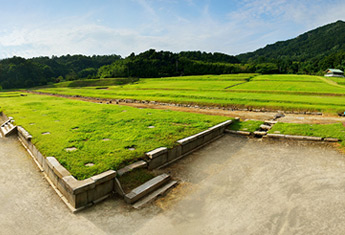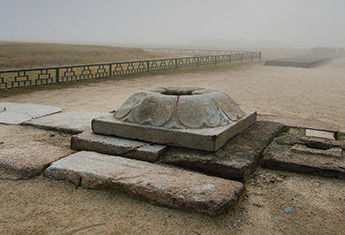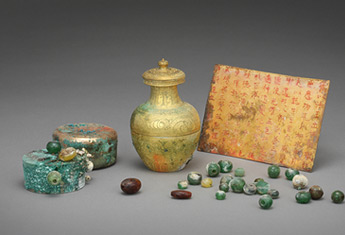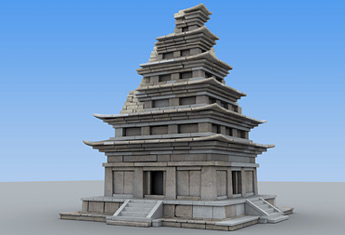Mireuksa Temple Site
The Wanggung-ri Site Museum strives to widely acknowledge and maintain the values of the Baekje Historic Area.
- Mireuksa Temple Site
- The Mireuksa temple site is between the hill at the bottom of Mireuk Mountain in Geumma-myeon, Iksan-si. It is the largest temple in East Asia. Its founding was recorded in the King Mu Section in the Legends and History of the Three Kingdoms.
- Mireuksa Temple Site Stone Pagoda
- Mireuksa Temple Site Stone Pagoda is on the west of the temple site. It is the origin of the stone pagoda in Korea that definitively demonstrates the process of change from wooden pagodas to stone pagodas as the best and largest stone pagoda existing in Korea.
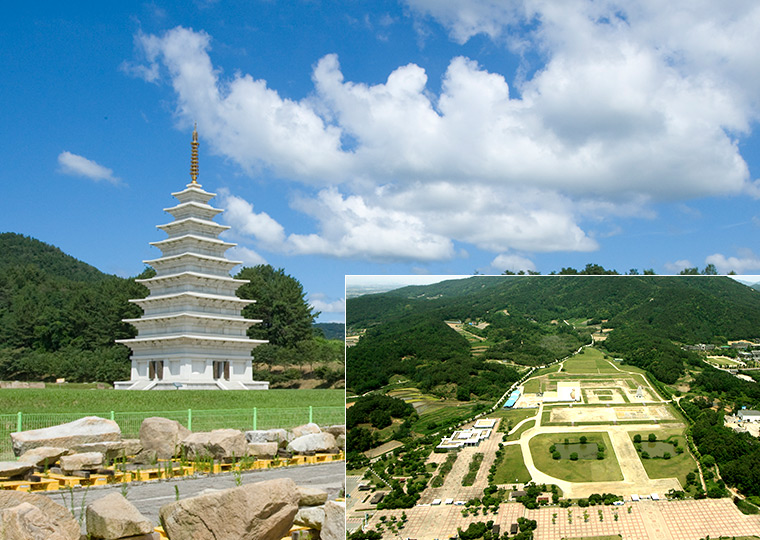
- On the way to Sajasa Temple for Buddhist prayer, King Mu and his queen encountered a Buddha triad around a pond at the bottom of Yonghwasan Mountain. In accordance with the queen’s request, the pond was filled in and the pagoda, main building and corridor were made, three of each. The records indicated that Mireuksa Temple was a national temple that strengthened the national power of Baekje. A wetland was filled in to create flat ground. The temple buildings were arranged in accordance with the Scripture of the Maitreya’s Advent telling that the Maitreya, the future Buddha, will come to Dosolcheon Stream and save all peoples through the three Buddhist teachings.
- The fact above was confirmed through the excavation from 1980 to 1995. The excavation found that the inner gate, pagoda, main building, auditorium, corridor and Buddhist dormitory were built during the reign of King Mu in the Baekje period and the flagpoles (only supports remain now) on the southern part and the south gate area were expanded during the Unified Silla period. The middle area, the east area and the pond on the southern part were sequentially demolished due to lightning damage with the wooden pagoda in the middle area as the start; buildings were built on the west of the west stone pagoda. The temple was used near the west stone pagoda during the Goryeo period. The temple was managed only around the northern area of the temple (one level higher than the pagoda and the Geumdangji site) during the Joseon period. It appears that the temple was ended around the time of the Japanese invasion in 1592.
- The general temple of Baekje has one main building with one pagoda. The Mireuksa temple site has a special arrangement, with three sets of pagodas and main buildings from east to west. by interpreting the pagoda and main building as the temple, the temple site was divided into a middle area, east area and west area. The middle area has a wooden pagoda. The east and west areas have stone pagodas.
- Three sets of pagodas and main buildings were arranged in Mireuksa Temple in accordance with Scripture regarding the Maitreya’s Advent indicating that the Maitreya would come to save all people through the three Buddhist teachings when the Maitreya descended from heaven into this world. It is thought that the present Mireuk Mountain was called Yonghwa Mountain and the process for getting to Sajasa Temple indicates the process of the Maitreya’s advent.
- The pagoda sites and main building sites in the Mireuksa temple site were built of a double foundation using granite. The auditorium site had a single foundation. This type of structure is the most advanced structure representing Baekje architecture regarding the structural or configurative aspects.
- The east pagoda was restored on the present Mireuksa Temple site. The base of a pagoda finial between the body of the pagoda and the finial was found near the east pagoda site during excavation. Nine kinds of roof stones in each layer of the pagoda in different sizes were found and it was concluded that there had been a 9-story pagoda. Those stones that had no safety issues from among the stones found near the east pagoda recovery process in 1992 were selected and reused.
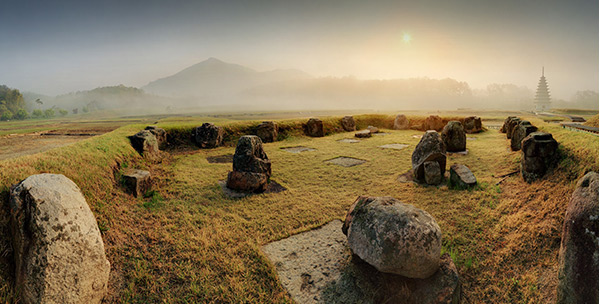
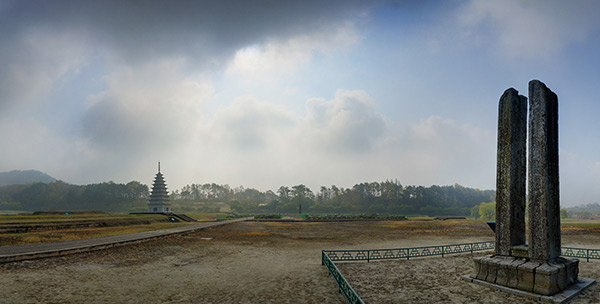
- The stone pagoda (east pagoda) in the Mireuksa temple site had six stories. The western and southern parts of the pagoda were adhered with cement. The pagoda had a humble appearance due to water leakage as well as having safety issues. The process of dismantling and restoring the stone pagoda started in 2001. During the process of dismantling the stone pagoda in Jan. 2009, about 10,000 Buddhist relinquary including a golden Sarira reliquary, golden Sarira enrichment record, golden tweezers, gold bar, golden earrings, silver crown ornaments, bronze bowl, golden thread, glass beads, and glass plates were found in the Sarira hole, which was 24.8cm wide and 27cm deep, in the top center of the core stone right above the cross-shaped passage of the pagoda.
- The most noteworthy items are the golden Sarira bowl and Sarira enrichment record. A small bowl was found inside the golden Sarira bowl and the Sarira was enshrined in the glass bottle in the small bowl. The Sarira enrichment record had letters engraved by intaglio on both sides of the 15.5cm wide and 10.5cm long board. A total of 193 letters were engraved, eleven lines with nine letters per line. It describes the process of building the stone pagoda: “The queen of the Baekje kingdom was the daughter of Jwapyeong Satakjeokdeok. She built the temple by donating property (offertory) and enshrined the Sarira on Jan. 29, 639 (Gihae year).” There was a movement denying Song of Seodong because the description recorded during the period building the stone pagoda was different from the story of Seodong and the princess Seonhwa after the Buddhist relinquary was found.
- However, this interpretation was an error by a literature historian who never considered the special features of the Mireuksa temple site. The Mireuksa temple site has a special arrangement with three pagodas and three main buildings (parallel arrangement of three sets), which was not found in the Goguryeo, Baekje or Silla regions as per excavation work. This is because the literature historian tried to understand the entire site of the Mireuksa temple based only on the pagoda to the west without considering the fact that there were three pagodas there. The wooden pagoda was in the center of the Mireuksa temple site and the stone pagodas were in the east and west sections.
- Of the three pagodas, the Sarira enrichment record concerns only the period of building the pagoda to the west. It appears that the wooden pagoda in the center was larger and taller than the stone pagodas on the east and west. Construction of Mireuksa Temple may have started from the wooden pagoda and the main building in the center of the site. This part was described in the record stating that Mireuksa temple construction was started on the suggestion of the princess Seonhwa but that the princess passed away without seeing the completion of the construction. Then, the daughter of Jwapyeong Satakjeokdeok became queen and completed the west pagoda.
- The Mireuksa temple site stone pagoda (west pagoda) will be completely restored by the end of 2018 after enshrining the Sarira found in Dec. 2015.
